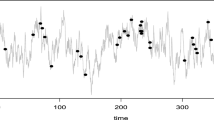Abstract
Detecting structural breaks is an essential task for the statistical analysis of time series, for example, for fitting parametric models to it. In short, structural breaks are points in time at which the behaviour of the time series substantially changes. Typically, no solid background knowledge of the time series under consideration is available. Therefore, a black-box optimization approach is our method of choice for detecting structural breaks. We describe a genetic algorithm framework which easily adapts to a large number of statistical settings. To evaluate the usefulness of different crossover and mutation operations for this problem, we conduct extensive experiments to determine good choices for the parameters and operators of the genetic algorithm. One surprising observation is that use of uniform and one-point crossover together gave significantly better results than using either crossover operator alone. Moreover, we present a specific fitness function which exploits the sparse structure of the break points and which can be evaluated particularly efficiently. The experiments on artificial and real-world time series show that the resulting algorithm detects break points with high precision and is computationally very efficient. A reference implementation with the data used in this paper is available as an applet at the following address: http://www.imm.dtu.dk/~pafi/TSX/. It has also been implemented as package SBRect for the statistics language R.









Similar content being viewed by others
Notes
For the range minimum/maximum problem, a solution using O(T) time and space and O(1) query time is known, see Fischer and Heun (2011). We choose not to use this method because of its implementation overhead and because it does not generalize to other statistical models like AR-models.
References
Bäck T, Fogel DB, Michalewicz Z (eds) (1997) Handbook of Evolutionary Computation, 1st edn. IOP Publishing Ltd., Bristol
Bardet JM, Kengne W, Wintenberger O (2012) Multiple breaks detection in general causal time series using penalized quasi-likelihood. Electron J Stat 6:435–477
Bentley JL (1979) Decomposable searching problems. Inf Process Lett 8(5):244–251
Chen Y, Härdle WK, Pigorsch U (2010) Localized realized volatility modeling. J Am Stat Assoc 105(492):1376–1393
de Berg M, van Krefeld M, Overmars M, Schwarzkopf O (2000) Computational Geometry: Algorithms and Applications, 2nd edn. Springer
Davis R, Lee T, Rodriguez-Yam G (2006) Structural break estimation for nonstatinary time series models. J Am Stat Assoc 101(473):223–239
Davis R, Lee T, Rodriguez-Yam G (2008) Break detection for a class of nonlinear time series models. J Time Ser Anal 29:834–867
De Grauwe P, Ji Y (2012) Mispricing of sovereign risk and multiple equilibria in the eurozone. Centre for European Policy Working Paper 361
De Wachter S, Tzavalis E (2012) Detection of structural breaks in linear dynamic panel data models. Comput Stat Data Anal 56(11):3020–3034
Deb K, Mohan M, Mishra S (2005) Evaluating the domination based multiobjective evolutionary algorithm for a quick computation of pareto-optimal solutions. Evol Comput J 13(4):501–525
Fischer J, Heun V (2011) Space-efficient preprocessing schemes for range minimum queries on static arrays. SIAM J Comput 40:465–492
Fischer P, Hilbert A (2014) Fast detection of structural breaks. In: Proceedings of 21th International Conference on Computational Statistics 2014, pp 9–16
Gaetan C (2000) Subset arma model identification using genetic algorithms. J Time Ser Anal 21(5):559–570
Hillebrand E, Medeiros MC (2014) Nonlinearity, breaks, and long-range dependence in time-series models. J Bus Econ Stat (just-accepted):00–00
Jansen T, Zarges C (2011) Analysis of evolutionary algorithms: From computational complexity analysis to algorithm engineering. In: Proceedings of the 11th ACM SIGEVO Workshop on Foundations of Genetic Algorithms (FOGA 2011), ACM Press, pp 1–14
Jong K, Marchiori E, van der Vaart A, Ylstra B, Weiss M, Meijer G (2003) Chromosomal breakpoint detection in human cancer. In: Proceedings Applications of Evolutionary Computing, EvoWorkshop 2003: EvoBIO, EvoCOP, EvoIASP, EvoMUSART, EvoROB, and EvoSTIM, Essex, UK, April 14-16, 2003, pp 54–65. doi:10.1007/3-540-36605-9_6
Kanpur_Genetic_Algorithms_Laboratory (2005-2015) Kangal. Website, http://www.iitk.ac.in/kangal/codes.shtml
Knuth D (1969) The Art of Computer Programming, vol II. Addison-Wesley
Lee TC (2002) Automatic smoothing for discontinuous regression functions. Stat Sin 12(3):823–842
Meligkotsidou L, Vrontos ID (2014) Detecting structural breaks in multivariate financial time series: evidence from hedge fund investment strategies. J Stat Comput Simul 84(5):1115–1135
Morales L, Gassie E (2011) Structural breaks and financial volatility: Lessons from bric countries. Leibniz-Institut für Agrarentwicklung in Mittel- und Osteuropa (IAMO), Halle (Saale), no. 13 in IAMO Forum 2011. http://hdl.handle.net/10419/50791
Nunkesser R, Morell O (2010) An evolutionary algorithm for robust regression. Comput Stat Data Anal 54(12):3242–3248
Preuß P, Puchstein R, Dette H (2015) Detection of multiple structural breaks in multivariate time series. J Am Stat Assoc 110:654–668
Rapach DE, Wohar ME (eds) (2008) Frontiers of Economics and Globalization, vol 3, Forecasting in the Presence of Structural Breaks and Model Uncertainty. Emerald
Rubner Y, Tomasi C, Guibas L (2000) The earth mover’s distance as a metric for image retrieval. Int J Comput Vis 40(2):99–121. doi:10.1023/A:1026543900054
Acknowledgments
Paul Fischer gratefully acknowledges support by DTU’s Corrit travel grant. Benjamin Doerr was supported through grant WI 3552/1-1 by the German Research Foundation (DFG) while visiting the Technical University of Denmark in 2012.
Author information
Authors and Affiliations
Corresponding author
Ethics declarations
Conflict of interest
The authors declare that they have no conflict of interest.
Additional information
Communicated by V. Loia.
A short version of the paper appeared in the proceedings of GECCO 2013 (as poster).
Appendix: Notation
Rights and permissions
About this article
Cite this article
Doerr, B., Fischer, P., Hilbert, A. et al. Detecting structural breaks in time series via genetic algorithms. Soft Comput 21, 4707–4720 (2017). https://doi.org/10.1007/s00500-016-2079-0
Published:
Issue Date:
DOI: https://doi.org/10.1007/s00500-016-2079-0




